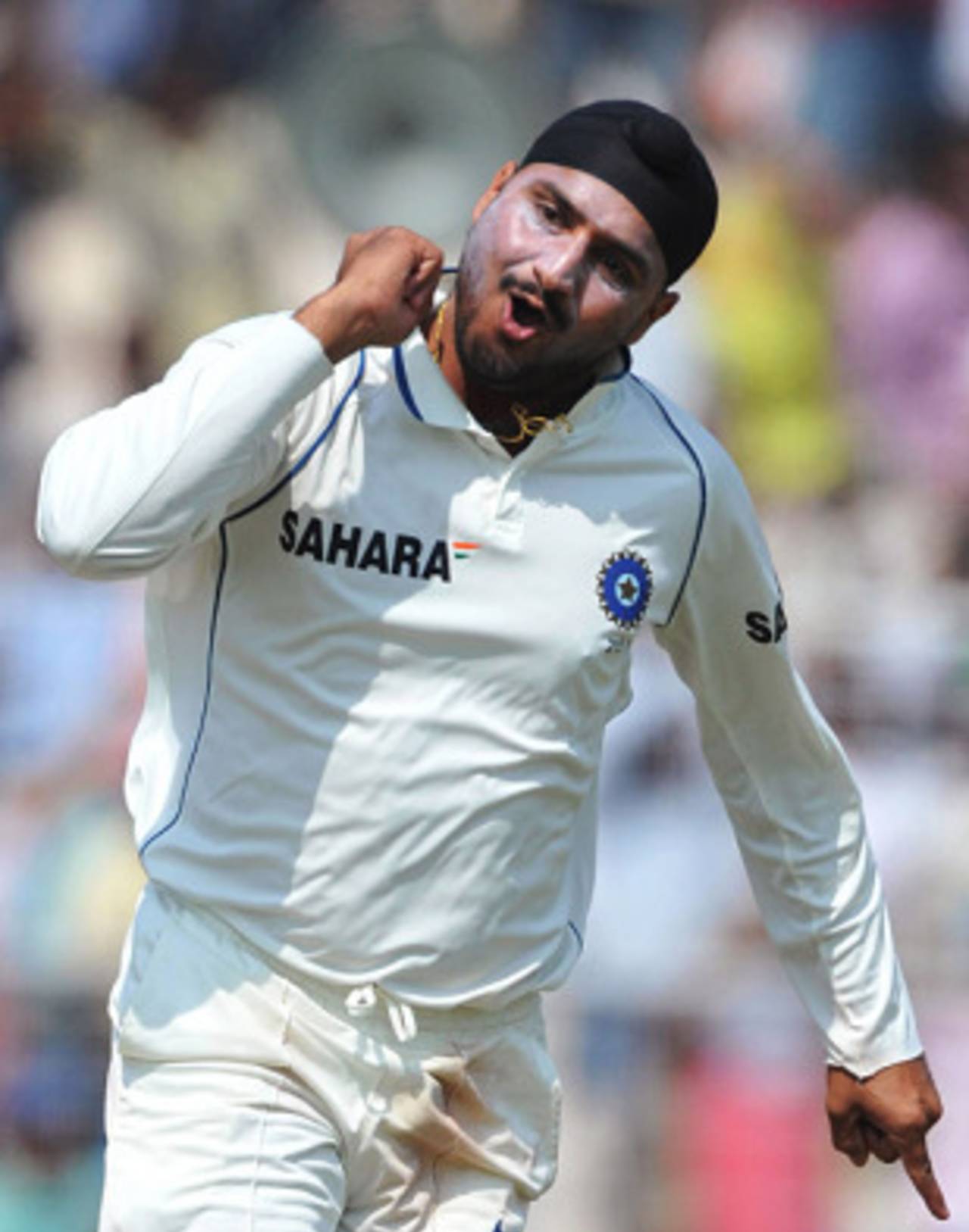Grand theatre lights up Indian victory
India's bowlers found their straps in an unrivalled atmosphere at the Eden Gardens to prevail in a thrilling encounter
S Aga
18-Feb-2010

Harbhajan Singh, not for the first time at the Eden Gardens, played a pivotal role in India's success • Getty Images
As Amit Mishra bowled the 131st over of the innings, with South Africa a minimum of 18 balls from survival, the stands at the Eden Gardens resembled a cauldron about to bubble over. The only man impervious to it all was Hashim Amla. Leg break, googly, slider - it made no difference to him. As each ball was painstakingly kept out with no hint of fatigue, some fans became exasperated. A policeman stormed off in a huff to smoke in the stairwell, a young man stamped his feet and others just groaned.
Then, as though they were aware of how the collective mood might affect those on the field, the backdrop was transformed. By the time Harbhajan Singh had the ball in his hand at the High Court End, most people in the crowd were on their feet. Many clapped a staccato beat, others roared. A turbaned Sikh at the front of the stand above the clubhouse waved the Indian flag as Sourav Ganguly had once whirled his shirt at Lord's. It could have been the Rumble in the Jungle.
It was pure theatre. When the umpire's finger went up three balls later and Morne Morkel sank to his knees in despair, the Eden roar that once celebrated the halting of an Australian juggernaut could be heard again. In their infinite wisdom, India's cricket administrators had scheduled no Test cricket here since December 2007, giving games to undeserving venues where barely a couple of thousand bother to turn up. Here, the 12th-man factor was undeniable, and it only reasserted why this hallowed ground is the true cathedral of Indian cricket.
Every great amphitheatre needs its heroes though, and India found several on a day when fortunes ebbed and flowed as they can only in the most intriguing form of the game. The loss of Zaheer Khan, usually so effective with the old ball, would have been disheartening but MS Dhoni mixed and matched his resources to get the best possible results.
Predictably, Harbhajan was right in the thick of things. Back in 2001, he had taken 13 of the Australian wickets to fall. And in 2004, it was his 7 for 87 in the second innings that clinched a series victory against Graeme Smith's side. There's something about the buzz at this ground that appeals to his gladiatorial instincts, and he was magnificent on a final-day pitch that was as far from being a bunsen as you could imagine.
Extra flight and a more tempting line ended Ashwell Prince's morning of defiance, while JP Duminy made the mistake of trying to negotiate him from well within the crease. Dale Steyn was clueless about one looped beautifully from round the wicket and then Morkel, after a 126-ball partnership with Amla, was struck on the pad by one that beat his tentative push. After some of the rubbish aired on television in the past week, you could forgive him the angry gesticulations. He had more than proved his point.
As had Mishra. Wicketless in Nagpur and discarded for the second Test in Bangladesh, he has had the unenviable task of trying to fit into Anil Kumble's size 11s. And while Harbhajan will get the plaudits, it shouldn't be forgotten that it was Mishra who removed two South African batsmen capable of playing epic innings, Graeme Smith and Jacques Kallis. On the final day, he added the wicket of AB de Villiers, the hero of the Perth run-chase befuddled by a perfectly pitched googly.
Spare a thought too for Ishant Sharma, struggling for form and rhythm and entrusted with a man's job in Zaheer's absence. Some of the balls he bowled betrayed his problems, but he deserves immense credit for persevering. Wayne Parnell had annoyed the Indians for nearly 25 overs when Ishant induced a lazy stroke, and the wicket of Paul Harris, who played his part in the MCG heist of 2008, was just as vital.
And what of Dhoni? The purists will quibble at the fields he set, with the silly point missing for long periods and Amla given freedom to work the ball around, but he kept rotating the bowlers all day in conditions where you had to do far more than land the ball on a rough patch. The introduction of Sachin Tendulkar was almost an inspired move, with Morkel fortunate to survive a Warne-like delivery, and even when the game appeared to be slipping away, the mask of composure that he wears so well remained.
The victory against Australia at the Wankhede in 2004 had this edge-of-seat quality, albeit on a pitch that reduced batsmanship to roulette. But unlike that dead rubber, this was a match with plenty at stake. The media obsessed about the No.1 ranking, but for the players it was primarily about restoring pride after they had allowed South Africa to walk all over them in Nagpur.
Such tests of character and rites of passage are mandatory for any side aspiring for champion status. Over the past two years, India have passed several with flying colours. The greatest one awaits in South Africa at the end of the year. Given how this rivalry has grown in stature, that series can't come soon enough.